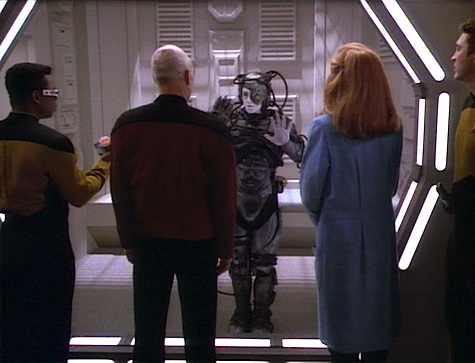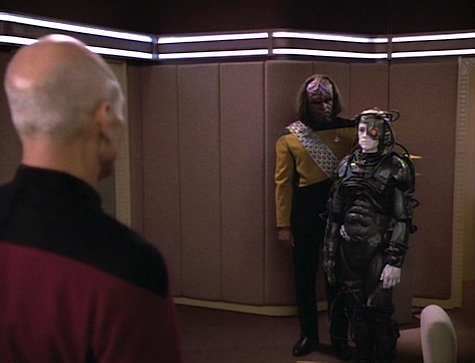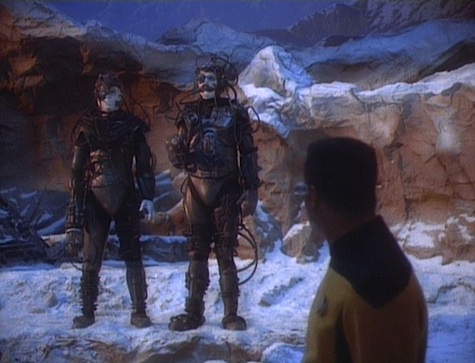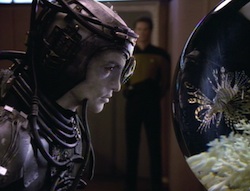“I, Borg”
Written by Rene Echevarria
Directed by Robert Lederman
Season 5, Episode 23
Production episode 40275-223
Original air date: May 11, 1992
Stardate: 45854.2
Captain’s Log: The Enterprise is exploring a region that might be viable for colonization when Data detects a signal from a Class-M moon orbiting the fourth planet of the system. In case it’s a distress signal, they head over. Riker, Worf, and Crusher beam down to find a downed Borg ship and one life sign—an injured Borg drone. There’s no indication of any other Borg activity—at least not yet. There are four other drones, all dead.
Picard’s initial instinct is to leave as quickly as possible (as soon as Riker says the word “Borg,” he becomes apprehensive to say the least), but Crusher can’t just leave a dying person behind. Picard agrees, having the drone beamed to a detention cell. Crusher will work on him there, and La Forge sets up a subspace field so the drone can’t communicate with the rest of the collective.
The implants in the Borg’s brain are causing problems, but Picard explains to Crusher that she can’t remove them permanently without killing him, as their brains over time grow too dependent on the implants. (One assumes that Picard wasn’t a Borg long enough for that to be an issue.) She suggests La Forge construct new implants, and Picard wonders if they can program those implants to place an invasive program into the Borg’s brain—which could be transferred to the rest of the collective, acting like a virus.
In a meeting, they discuss options, and La Forge and Data believe they can construct an invasive program that would, within a few months, result in total systems failure. Crusher makes it clear that by “total systems failure,” they’re talking about genocide here, but Picard insists that it’s the only option. They can’t negotiate with the Borg, and the Borg have made it clear that they only wish to assimilate humanity.
The drone wakes up, and seeks out an access terminal that it can’t find in the holding cell. Crusher says that if she didn’t know better, she’d say he was scared.

Picard and Guinan fence, and Guinan thinks that having the drone on board is a mistake. “They’ll come after us, you know that.” As if to prove the point, when they have another go, Guinan fakes an injury while they fence. When Picard asks if she’s all right, she touches him with her foil. “You felt sorry for me, look where it got you.”
La Forge needs to give the drone an energy conduit so it can feed. Worf accompanies La Forge into the cell when the latter hooks it up. The drone starts the usual Borg rant about assimilation and resistance being futile, and all that. He identifies himself as Third of Five.
Crusher and La Forge beam him to the lab so they can work on the program. Crusher is still not happy about it. Third of Five is confused about what a doctor does—the sick and injured are just reabsorbed into the collective. They want to ask him some questions—ostensibly to see if the new implants are working, but really so La Forge can figure out how his cybernetic pathways work so he can put in the invasive program. Third of Five asks Crusher and La Forge for their designations, and they explain that they have names, instead. “I’m Beverly, he’s Geordi, and you—” He repeats the word “you,” and La Forge then decides to go all punny on us and gives him the name “Hugh.” “We are Hugh,” the drone agrees.
Hugh explains how quiet it is on the Enterprise; he’s used to the voices of all the other drones on board a ship. Crusher realizes that he’s lonely. Hugh also wants to know what will happen to him. La Forge sorta kinda tells the truth when he replies that he’ll be returned to the collective.
Speaking of whom, long-range sensors pick up a Borg scout ship en route to the star system. It will arrive in 31 hours.
Going for a drink in Ten-Forward, La Forge finds Guinan an unusually unsympathetic ear, as she is revolted at the idea of naming the Borg and individualizing it and that he has second thoughts about their plan. She reminds La Forge that that “kid’s” big brothers will be by soon enough, and they will destroy the Enterprise without any of his soul searching.
Angrily La Forge says she should try talking to Hugh before passing judgment. She says she has nothing to say to him, and La Forge says maybe she should just listen, which is what she claims she’s best at. So she goes to the detention cell, tells Hugh that her people did resist the Borg. They have no homeworld, and there are very few of her species left, but still resistance was not futile. Hugh realizes that Guinan is lonely—just as Crusher said he was.

Hugh asks La Forge a lot of questions, and La Forge explains about individuality versus being part of a collective. When Hugh asks how he deals with loneliness, he says he has friends, and Hugh decides that he and La Forge are friends.
Data and La Forge show Picard their “virus”—it’s a complex geometric form, a paradox that cannot actually exist in reality. Hugh will try to analyze it, as will the collective when they reabsorb Hugh; each analysis will provide a different anomalous result, and those anomalies will interact with each other and cause more anomalies, eventually overwhelming the collective, causing a system shutdown. La Forge also confesses his second thoughts to Picard, whose response is to cite scientists who got overly attached to laboratory animals, and he coldly tells La Forge to unattach himself from Hugh.
Guinan comes to visit Picard in his quarters, as visiting Hugh has also given her second thoughts. Picard is aghast, considering that two days ago she was so angry at even having him on board, she tore his foil out of his hands. Guinan is similarly aghast to learn that Picard hasn’t actually talked to Hugh. “If you are going to use this person to destroy his race, you should at least look him in the eye once before you do it.”

Picard has Hugh beamed into his ready room, accompanied by Worf. Picard tells Worf to wait outside, which the Klingon is not happy about. Hugh greets Picard as Locutus, and Picard immediately takes on that role. He instructs Hugh to identify himself. At first, he calls himself Hugh, but after “Locutus” tells him that isn’t a Borg designation, he finally says he’s Third of Five. He tells “Locutus” that humans don’t wish to be assimilated and that they will resist. Hugh actually pleads for La Forge’s life, saying the engineer does not wish to be assimilated, and Hugh doesn’t want La Forge to die, which is the altnerative.
When “Locutus” instructs Third of Five to assist him in readying this ship for assimilation, Hugh says, “I will not help you,” and Picard is shocked to hear the first-person-single pronoun rather than the ubiquitous “we.” When Picard insists that he’s Borg, he says, “No, I am Hugh.”
Picard meets with Riker, La Forge, and Crusher to discuss other options, as he has come to realize that their original plan would make them no better than the Borg. The option they come up with is actually very similar to the first one, except the “invasive program” that Hugh will bring back to the collective is the very notion of individuality. That could be just as devastating to the Borg as the paradoxical geometric shape, and certainly more compassionate.
Crusher brings up an excellent point, though: what if Hugh doesn’t want to go back?
So Picard and La Forge ask Hugh, and he’s confused and amazed at the concept of choice. He would choose to stay with La Forge if he could, but he also knows that the Borg will never stop looking for him, and for the sake of his new friends, he must go back. La Forge asks to accompany him to the crash site, while the Enterprise hides in the sun’s chromospheres until the Borg are gone. Hugh says goodbye to La Forge, saying he will try to remember him.

Two Borg materialize on the surface, examine Hugh—or, rather, Third of Five—remove components from the other four, causing them to disintegrate, and then the three of them transport away.
Can’t We Just Reverse the Polarity?: Because a more traditional invasive program would be detected by the Borg (one assumes they regularly update their Norton Utilities…), Data and La Forge decide to hit it with a mathematical paradox—it’s a charmingly more sophisticated version of Kirk and the gang wiping out Norman in the similarly titled “I, Mudd” with a verbal paradox on the original series.
Thank You, Counselor Obvious: Troi tries to get Picard to talk about how he feels about having a Borg drone on board, and Picard shuts her completely down.
There is No Honor in Being Pummeled: Worf’s initial recommendation is to kill the drone and make it look like he died in the crash, leaving no evidence that they were there. It’s a smart recommendation on the face of it, but the coldness of it acts like a bucket of ice water in Picard’s face, and in an odd way seems to lead to his agreeing to beam the future Hugh on board.
Worf is notably not consulted on anything other than security for the rest of the episode, which is kind of too bad, as I doubt he would change his position the way Picard and Guinan did. However, a Klingon argument—he’s the enemy, kill him—probably wouldn’t have advanced the episode’s point.
Syntheholics Anonymous: Guinan’s usual compassion-o-meter is on the fritz where the Borg are concerned, since they wiped out her people, and like everyone else, she’s shocked when Hugh turns out to be a person.

I Believe I Said That: “Resistance—is not futile?”
Hugh having his whole world turned upside down by La Forge.
Welcome Aboard: Only one real guest, beyond the recurring Whoopi Goldberg—turning in a particularly good performance as a Guinan out of her comfort zone—and that’s the spectacular Jonthan del Arco as Hugh, f.k.a. Third of Five, who gives a subtle, powerful performance.
Trivial Matters: Peter David’s TNG novel Vendetta, which came out a year prior to this episode’s airing, also had La Forge dealing with a Borg separated from the collective, but in that novel the drone was unable to move past the collective nor regain any sense of individuality.
Hugh’s “invasive program” will affect a segment of Borg, as we’ll see when Hugh returns in “Descent.”
This story picks up on Picard’s experiences being assimilated by the Borg and its emotional fallout in the two parts of “The Best of Both Worlds” and in “Family,” which inform how Crusher and La Forge proceed (since Picard has insider knowledge of how the Borg function), and also has a severe impact on his decision-making and his emotions. Notably, when the Borg return in Star Trek: First Contact, that movie’s script acts as if this episode (and “Descent”) never happened.
The Borg nomenclature of “X of Y,” where Y is a number greater than or equal to X, is established in this episode, and will be seen again most obviously in the Voyager regular Seven of Nine.
This is one of only two TNG episodes directed by Robert Lederman (“Force of Nature” will be the other), who mostly served as an editor on all four modern Trek spinoffs. This is also the first Borg episode not to be scored by Ron Jones, who scored both “Q Who” and both parts of “The Best of Both Worlds.” The music for this one was by Jay Chattaway, who will also score both parts of “Descent,” the Borg’s next and final TNG appearance, as well as several Borg-focused Voyager episodes (notably both parts of “Scorpion”).
This is the second time we’ve seen Picard fence, having seen him don mask and foil previously in “We’ll Always Have Paris.”
This is one of many titles all over pop culture that riff on the title of the Robert Graves novel I, Claudius (the BBC adaptation of which featured Sir Patrick Stewart as Sejanus). Probably the most famous riff on it is Isaac Asimov’s story cycle I, Robot.
Make it So: “We are Hugh.” I have conflicting feelings about this episode, but a lot of the negative feelings aren’t really this episode’s fault, but rather what this storyline led to, to wit, the defanging of the Borg.
But then again, I can’t really blame the writers for taking this route, because what makes the Borg awesome is also what makes it impossible to write for them. The Borg as we saw in “Q Who” are unstoppable—and, in fact, our heroes couldn’t stop them there, needing Q’s intervention to even survive. Even if you find a way to beat them, they adjust and that won’t work twice, and so far the only way anyone came up with to beat them (in “The Best of Both Worlds Part II”) was pretty darned lame.
Worse, the Borg are force-of-nature villains, which makes it hard to come up with stories for them on a regular basis. The best recurring villains are ones with personality, and the Borg can’t possibly have that.
Or can they? The door to this episode was opened by Picard’s being assimilated by the Borg in “The Best of Both Worlds” and then reverted back to human in Part 2—and just generally in the notion that the Borg assimilate other species into Borg. So what happens if one is separated from the collective and the person he or she was starts to come to the fore?

Echevarria’s script is beautifully done, as we start with La Forge and Crusher, who default to compassion in any case, the latter as a doctor, the former as a (mostly) likeable nerd. I particularly like that Crusher refuses to coat anything in euphemisms, and reminding everyone that they’re actually talking about genocide.
But what makes the episode shine is Picard and Guinan, two characters who are normally the very model of compassion, but who both have (perfectly understandable) blind spots when it comes to the Borg. Watching their transformation from vengeance-fueled anger (though neither admits this is the case) to the compassion that would be their characters’ default with any other species is one of the episode’s many high points.
However, the longer he’s separated from the collective, the more individual this drone becomes—Third of Five becomes Hugh—and the more it becomes impossible to use him as a weapon. When Hugh cowered from what he thought was Locutus and said he did not want to hurt his friend, I found myself reminded (favorably) of Pulaski’s line in “Pen Pals” when she says that Data’s friend is in trouble and that means something—and it means something here, because Hugh is just as much an individual as Data is, and the rights Picard fought for regarding Data in both “The Measure of a Man” and “The Offspring” apply to Hugh as well.
This episode changed the Borg, truly, because it became impossible to think of them as entirely evil bad guy drones. They’ve become humanized, which can make for a more interesting story, but makes for worse villains. (Indeed, the character of Seven of Nine goes on a journey similar to that of Hugh, only she spends several seasons of a TV show doing it.) This episode also made it easier to do Borg stories, which also served to render them less interesting, as an unstoppable foe becomes less impressive with overuse, and the Borg have indeed been seriously overused at his point.
Ultimately, though, I can’t really blame the episode for what came later, and this is a very strong story, one that deeply affects several characters on a deep, personal level, and in two cases makes them confront their prejudices and their demons. Plus, it’s never a bad thing when TNG actually remembers its character continuity.
Warp factor rating: 8
Keith R.A. DeCandido has never written the Borg in his Star Trek fiction, unless you include Picard channeling Locutus in his Perchance to Dream comic book miniseries.










